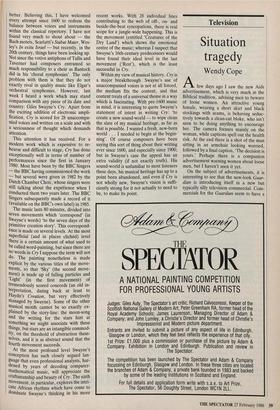Musi c
Brave new sound-world
Peter Phillips
According to my own potted view, Western musical history has been divided into two fundamental spans: the first, from the year dot to 1600, when voices in sacred writing formed the means by which every- thing was judged, and the second, from 1600 to the present day, when instruments in secular music have had the ascendancy. It will come as no surprise to anyone to learn, though I regret the fact, that the latter span has been so much the more popular that appreciation of the former is still in a state of infancy, if not nappies. Strangely, in this distinction the revival of interest in 'early' music has no relevan- cy, since this has centred on baroque instrumental writing and thus has done no more than provide a different angle on the same underlying preference. When people point out that music pre-1600 (rather than pre-1700) sounds very unfamiliar to them, the reason is not that the techniques of composition have changed out of recogni- tion but that for centuries we have not been in the habit of listening to unaccom- panied voices: perhaps there is scope for the lines of the early music campaign to be redrawn.
To me the music made by well blended, well tuned and unsupported voices is the most beautiful abstract sound available to us. Orchestras are good, but choirs trained to the same professional standard are better. Believing this, I have welcomed every attempt since 1600 to redress the balance between voices and instruments within the classical repertory. I have not found very much to shout about — the Bach motets, Scarlatti's Stabat Mater, Wes- ley's In exitu Israel — but recently, in the 20th century, things have been looking up. Not since the votive antiphons of Tallis and Taverner had composers entrusted so much responsibility to a choir as Bantock did in his 'choral symphonies'. The only problem with them is that they do not exactly rival in quality music like Elgar's orchestral symphonies. However, last week I heard a work which may stand comparison with any piece of its date and country: Giles Swayne's Cry. Apart from the exciting addition of electronic ampli- fication, Cry is scored for 28 unaccompa- nied voices and written on a scale and with a seriousness of thought which demands attention.
This attention it has received. For a modern work which is expensive to re- hearse and difficult to stage, Cry has done exceptionally well in terms of number of performances since the first in January 1980. Most have been by the BBC Singers — the BBC having commissioned the work — but several were given in 1982 by the Dutch Chamber Choir, whose singers were still talking about the expefience when I conducted them two years later. The BBC Singers subsequently made a record of it (available on the BBC's own label) in 1985.
The music lasts 80 minutes, divided into seven movements which 'correspond' (in Swayne's words) 'to the seven days of the Primitive creation story'. This correspond- ence is made on several levels. At the most superficial (and in places cliched) level there is a certain amount of what used to be called word-painting, but since there are no words in Cry I suppose the term will not do. The painting nonetheless is made explicit by the various titles of the move- ments, so that 'Sky' (the second move- ment) is made up of falling particles and `Light' (in the first movement) of tremendously scored concords (an old in- terpretation, dating back at least to Haydn's Creation, but very effectively managed by Swayne). Some of the other musical motifs cannot be so exactly ex- plained by the story-line: the moon-song and the writing for the stars hint at something we might associate with these things, but stars are an intangible commod- ity, on the threshold of abstraction them- selves, and it is as abstract sound that the fourth movement succeeds.
At the most profound level Swayne's conception has such closely argued lan- guage that even professional analysts, har- dened by years of decoding computer- mathematical music, will appreciate the craftsmanship and beauty of Cry. The sixth movement, in particular, explores the intri- cate African rhythms which have come to dominate Swayne's thinking in his more recent works. With 28 individual lines contributing to the web of off-, on- and beside-the-beat syncopations, there is real scope for a jungle-wide happening. This is the movement (entitled 'Creatures of the Dry Land') which shows the emotional centre of the music; whereas I suspect that Swayne's 16th-century predecessors would have found their ideal level in the last movement (`Rest'), which is the least successful in Cry.
Within my view of musical history, Cry is a major breakthrough. Swayne's use of unaccompanied voices is not at all forced, the medium fits the content, and that content treats of a universal theme in a way which is fascinating. With pre-1600 music in mind, it is interesting to quote Swayne's statement of intent in writing Cry: 'to create a new sound-world — to wipe clean the slate of my musical heritage, as far as that is possible. I wanted a fresh, new-born world . . . I needed to begin at the begin- ning'. Of course composers have been saying this sort of thing about their writing ever since 1600, and especially since 1900; but in Swayne's case the appeal has an extra validity (if not exactly truth). His sound-world is unfamiliar to most listeners these days, his musical heritage has up to a point been abandoned, and even if Cry is not wholly new, Swayne's vision is suffi- ciently strong for it not actually to need to be, to make its point.



















































 Previous page
Previous page